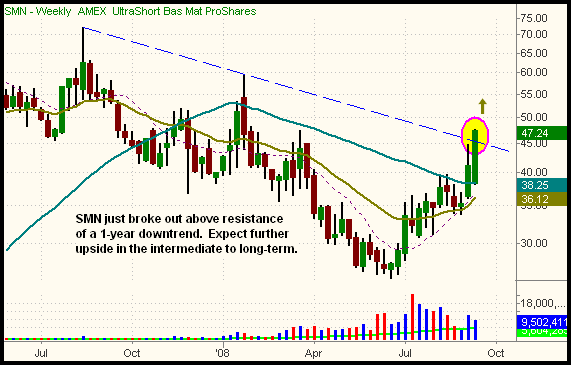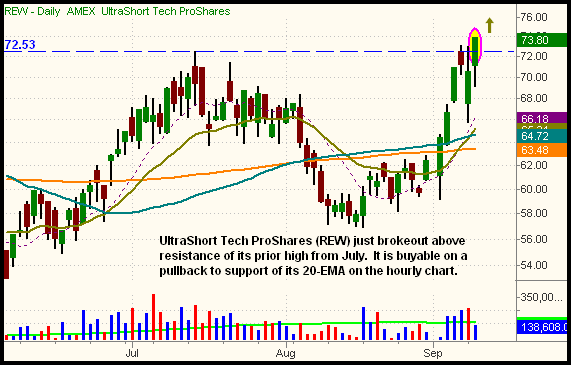|
The Wagner Daily ETF Report For September 10
Over the past two days, we've been suggesting a very cautious stance in the market until we saw whether or not the gains from the initial positive reaction to Monday's Fannie/Freddie news could be sustained. Just one day later, we seem to have already gotten our answer. Stocks opened near the flat line, but the bears quickly resumed control, sending the broad market into a steady downtrend that persisted throughout the entire session. By the closing bell, all the major indices had given back their previous day's gains, and a quite a bit more. The S&P 500 plunged 3.4%, the Nasdaq Composite 2.6%, and the Dow Jones Industrial Average 2.4%. Small and mid-cap stocks suffered the worst. The Russell 2000 tumbled 3.5% and the S&P Midcap 400 nosedived 3.9%. All the main stock market indexes closed at their dead lows of the day.
Total volume in the NYSE eased 2% from Monday's swift pace, while volume in the Nasdaq was on par with the previous day's level. Turnover remained well above average levels, pointing to the presence of institutional selling yesterday. Market internals were atrocious, as broad selling was noted in every major industry sector. In the NYSE, declining volume trounced advancing volume by a margin of 9 to 1. The Nasdaq adv/dec volume ratio was negative by an astonishing spread of 13 to 1. With such bearish market internals, there was nowhere for bulls to run and hide yesterday.
In yesterday's commentary, we expressed suspicion over the narrow breadth of Monday's news-inspired rally. Although both the S&P 500 and Dow Jones Industrial Average gained more than 2% that day, advancing volume in the NYSE was only nominally higher than declining volume. Because the rally was largely focused on the financial-related sectors, we said, "Our overall assessment is that it was nothing more than a sector-specific bear market rally." As such, we were not surprised that stocks moved lower yesterday; however, we didn't necessarily expect a sell-off of such magnitude to follow just one day later.
Fortunately, we avoided getting sucked into the excitement of Monday morning's knee-jerk rally that followed news of the U.S. government's seizure of Fannie Mae and Freddie Mac. With such massive amounts of overhead supply to contend with, we felt it would be difficult for the main stock market indexes to sustain Monday's initial gains without a period of price consolidation. Nevertheless, we also weren't keen on taking new short positions, as stocks had jumped back into their choppy, sideways ranges that challenged traders throughout much of August. Though we've intentionally avoided new positions so far this week, our only open ETF position, which we bought last week, is now looking great.
Yesterday, as the Basic Materials sector got creamed, the inversely correlated and leveraged UltraShort Basic Materials ProShares (SMN) rocketed 11% higher! Volume also swelled to more than twice its average level, indicating the presence of institutional selling in the sector. Because the basic materials sector moved lower, even as the S&P 500 gained more than 2% on Monday, it makes sense that the sector would show downside leadership when the broad market moved lower as well. Sectors with relative weakness are the last to move higher on the "up" days, and the first to fall apart on the "down" days in the broad market. These, of course, are the sectors we want to be short in bear markets. Looking at the longer-term weekly chart, notice how SMN has just broken out above a downtrend line that has been in place for more than a year:

SMN is already showing an unrealized gain of 14% since our September 5 buy entry, but our original price target is still a few points higher. Although SMN just broke out above its weekly downtrend line and looks higher in the intermediate to long-term, it's rallied quite sharply in the near-term. Since we're not interested in holding through a steep pullback, we'll be trailing a stop along the way, just to maximize gains while protecting profits.
As tech stocks are getting hammered, the inversely correlated UltraShort Technology ProShares (REW) has formed a bullish chart pattern. Moving above its prior high from July, REW is now a breakout play. A pullback to the area of its 20-EMA on the hourly chart presents a low-risk entry point, as we entered SMN in the same fashion. The daily chart of REW below shows the breakout:

Finishing at its lowest closing price since March of 2008, the Nasdaq Composite Index set a lower closing price than its prior low from July of 2008. The large-cap Nasdaq 100 brethren already fell below its July 2008 closing low on September 4. Now less than 1% above its July 2008 low, the S&P 500 also has a very high probability of at least testing its July low in the coming days. Such a move would also correspond to a test of its 52-week closing low.
After Monday's short-lived anomaly that caused traders to question the broad market's recent breakdown below key support levels, the main stock market indexes have again fallen back to the vicinity of last week's low. As such, the overall broad-based trends for the short-, intermediate-, and long-term have reverted back to bearish. Still, we think it's tricky to sell short the broad-based ETFs with blind abandon here. Instead, consider focusing on selling short specific industry sectors exhibiting relative weakness to the main stock market indexes. Doing so will decrease your overall risk, while increasing the odds of a profitable trade. Most importantly, remember to trade what you see, not what you think!
Open ETF positions:
Long - SMN
Short - (none, but SMN is a bearish position)
Deron Wagner is the Founder and Head Trader of both Morpheus Capital LP, a U.S. hedge fund, and Morpheus Trading Group, a trader education firm launched in 2001 that provides daily technical analysis of the leading ETFs and stocks. For a free trial to the full version of The Wagner Daily or to learn about Wagner's other services, visit MorpheusTrading.com or send an e-mail to deron@morpheustrading.com.
|